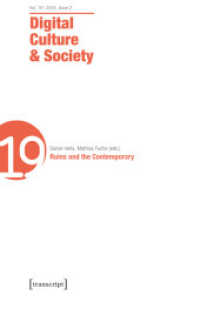- ホーム
- > 洋書
- > 英文書
- > Politics / International Relations
Full Description
Why do countries have different institutions and forms of government? Why do some social revolutions succeed and endure while others fail? Why are some societies subjected to terrorism and not others? An engaging and accessible introduction to the subject, Comparative Politics: Integrating Theories, Methods, and Cases, Second Edition, gives students the methodological tools they need to answer the "big questions" in the field. The authors introduce methodsearly in the text and integrate them throughout in order to help students develop a systematic way of thinking about comparative politics.FEATURES L * A unique structure offers the best of thematic and country-by-country approaches. Sixteen succinct thematic chapters-organized around the "big questions" in the field-are followed by a separate section at the end of the book offering full-length profiles and case studies for twelve countries* Each chapter integrates several standalone country case studies in "Case in Context" boxes; these features tie into the narrative, pose questions, and point students to the full case discussions in the country profiles* "Thinking Comparatively" sections at the end of each chapter introduce new methodological tools and help students apply the theories and concepts covered in that chapter* "Thinking It Through" questions help students test their ability to apply comparative politics theories to cases* "Research Prompts" in every case-study section help students develop comparative projects and papers
Contents
PART IPOLITICS; CONCEPTS; EMPIRICAL EVIDENCE; THE COMPARATIVE METHOD; IS THE STUDY EVIDENCE; HYPOTHESIS TESTING; CRITIQUES: USING THEORY AND EVIDENCE; THE STATE, DEVELOPMENT, DEMOCRACY, AND AUTHORITARIANISM; CHAPTER 3. THE STATE; CONCEPTS; TYPES; CAUSES AND EFFECTS: WHY DID STATES EMERGE AND EXPAND?; THINKING COMPARATIVELY: GREAT BRITAIN, THE UNITED KINGDOM, OR NEITHER? STATE HOW?; CHAPTER 5. DEVELOPMENT; CONCEPTS; TYPES; CAUSES AND EFFECTS: WHY DOES DEVELOPMENT HAPPEN (OR NOT)?; THINKING COMPARATIVELY: EXPLAINING THE DEMOCRATIZATION; CONCEPTS; TYPES; CAUSES AND EFFECTS: WHAT CAUSES DEMOCRATIZATION?; THINKING COMPARATIVELY: IS AMERICAN DEMOCRACY A MODEL?; CHAPTER 7. AUTHORITARIAN REGIMES AND DEMOCRATIC BREAKDOWN; CONCEPTS; TYPES; AUTHORITARIANISM; CAUSES AND EFFECTS: WHAT CAUSES AUTHORITARIAN REGIMES TO EMERGE AND PERSIST?; THINKING COMPARATIVELY: WHY DID ZIMBABWE BECOME AND CONSTITUTIONS AND CONSTITUTIONAL DESIGN; CONCEPTS; TYPES; CAUSES AND EFFECTS: EXPLAINS THE SIMILARITIES BETWEEN THE BRAZILIAN AND SOUTH AFRICAN CONSTITUTIONS?; CHAPTER 9. LEGISLATURES AND LEGISLATIVE ELECTIONS; CONCEPTS; EXECUTIVES; CONCEPTS; CONCEPTS; TYPES; CAUSES AND EFFECTS: WHAT EXPLAINS EXECUTIVE STABILITY?; THINKING COMPARATIVELY: BEYOND THE AMERICAN AND BRITISH MODELS; CHAPTER 11. POLITICAL PARTIES, PARTY SYSTEMS, AND INTEREST GROUPS; AFRICA; PART IV: POLITICS, SOCIETY, AND CULTURE; CHAPTER 12. REVOLUTIONS AND THINKING COMPARATIVELY: THE "ARAB SPRING" OF 2011; CHAPTER 13. NATIONALISM AND NATIONAL IDENTITY; CONCEPTS; TYPES; CAUSES AND EFFECTS: WHAT CAUSES ETHNO-NATIONAL CONFLICT?; THINKING COMPARATIVELY: ENDING ETHNIC AND NATIONAL VIOLENCE; CHAPTER 14. RACE, ETHNICITY, AND GENDER; CONCEPTS; TYPES; CAUSES CHAPTER 15. IDEOLOGY AND RELIGION; CONCEPTS; TYPES; CAUSES AND EFFECTS: WHY COMPARATIVE-INTERNATIONAL NEXUS; CHAPTER 16. COMPARATIVE POLITICS AND INTERNATIONAL RELATIONS; CONCEPTS; ISSUES; CAUSES AND EFFECTS: WHAT ARE THE POWER? (CH. 5); IS CHINA DESTINED FOR DEMOCRACY? (CH. 6); WHO GOVERNS CHINA? (CH. 10); THE CHINESE PARTY SYSTEM (CH. 11); THE CHINESE REVOLUTION (CH. 12); FRANCE; PROFILE; CASE STUDIES; GERMANY; PROFILE; CASE STUDIES; INDIA; STUDIES; JAPAN; CASE STUDIES; MEXICO; PROFILE; CASE STUDIES; NIGERIA; PROFILE; CASE STUDIES; RUSSIA; PROFILE; CASE STUDIES; UNITED KINGDOM; PROFILE; CASE STUDIES; UNITED STATES; PROFILE; CASE STUDIES








